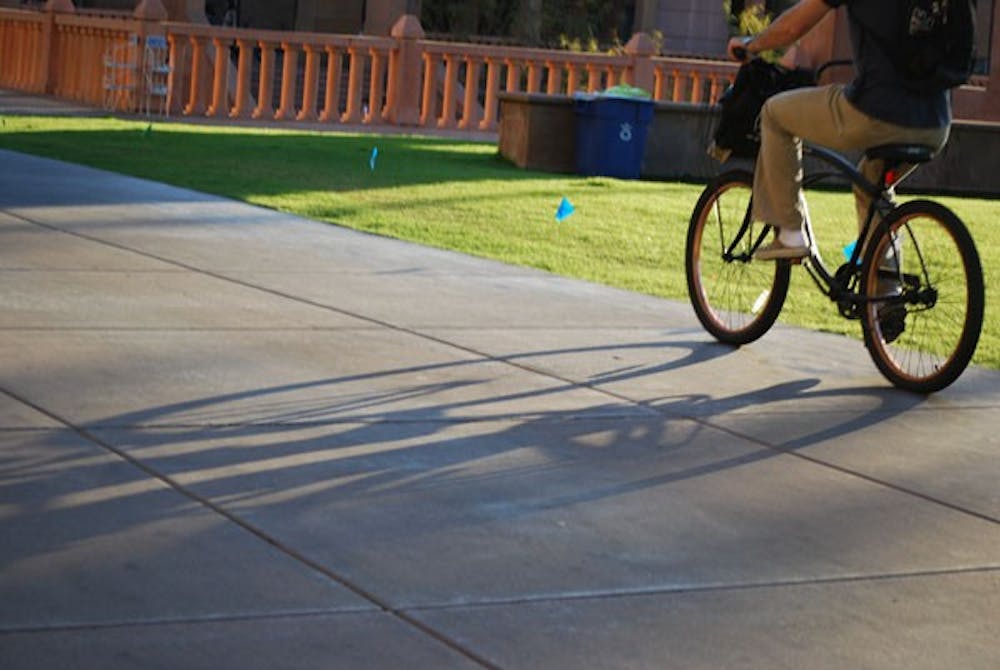 A student bikes down Cady Mall and past Hayden Lawn on the Tempe campus late Wednesday afternoon. (Photo by Murphy Bannerman)
A student bikes down Cady Mall and past Hayden Lawn on the Tempe campus late Wednesday afternoon. (Photo by Murphy Bannerman)The Office of the University Architect is heading a study to determine how to make the Tempe campus more transportation efficient for bicycles, long boards and pedestrians as enrollment continues to rise.
Landscape project manager Norman Yatabe said the study will address how all modes of transportation can coexist on the Tempe campus.
“This study was initiated over concerns about increasing conflicts between pedestrians, motorized and non-motorized vehicles on campus malls,” Yatabe said in an email.
He said the Office of the University Architect is working with at least 16 different University departments and offices, including the Fire Marshall, the Global Institute of Sustainability and the School of Earth and Space Exploration.
The study will inform the Tempe Campus Access Management Plan, which should be finalized and submitted for approval by December.
The plan will establish a long-term policy to create a safer inter-campus environment for motorized and non-motorized vehicles, as well as pedestrians, Yatabe said.
Ryan Furcini, president of the ASU Cycling Community, said campus officials have a responsibility to provide safe and expedient transportation options.
“(The Tempe campus) is so darn crowded with bikes and skateboards during the day,” he said. “For a school that markets itself as a sustainable innovator, ASU needs to figure out a new and more efficient way to incorporate bikes and other wheeled devices.”
Furcini, a civil engineering senior, said ASU could benefit from a system like the one at UA, which incorporates separate bicycle and pedestrian pathways along the same route.
“If there was a lane to avoid the crowds you would be able to get around so much quicker and safer on a bike,” he said.
Mike Marriott, a biology senior who has been working at the ASU Bike Co-op for nearly four years, said the Tempe campus would not benefit from separate bike lanes.
“It would be weird to partition the sidewalks and separate bikes from people,” he said. “It would throw things off, plus I don’t think anyone would follow the rules.”
Marriott said NAU’s bike lanes work well only because of the campus layout.
“At NAU you go from south campus to north campus, and it’s nice to have a dedicated bike lane for that,” he said. “But ASU doesn’t really have the kind of infrastructure that supports a bike lane everywhere.”
UA and NAU were both included on the League of American Bicyclists annual list of the nation's most bicycle-friendly universities, released in October.
Alison Dewey, spokeswoman for the League of American Bicyclists, said universities must apply to be on the list and no application was received from ASU.
“Universities that have large populations certainly have a lot of traffic to control, and bikes are a great solution to this problem and others,” she said.
Dewey said The Ohio State University is on the list and has a population of 64,000 students, very similar to that of ASU.
“OSU has invested more than $2 million over the last three years connecting campus to a larger city system of bicycle infrastructure, renovating a critical multi-use trail bisecting campus, constructing bike lanes and installing shared lane markings,” according to the League’s website.
Nick Petitpas, vice president of the Devil’s Rebels Longboarding Club, said bike lanes should be implemented on some scale and suggested doing so at high traffic areas such as Palm Walk.
“It’s hectic,” he said. “There are so many swarms of people when classes get out. It’s bikes that are really dangerous, so something like a separate lane would be really helpful.”
Arts and media engineering junior Dakota Gidley said he has been in three accidents while riding his bike on or near campus.
Gidley said on two separate occasions a car turning right on a red light hit him while he rode through the crosswalk.
He said he received an insurance payout in both cases.
Gidley said in the third accident, an ASU police golf cart hit him while he was riding on the wrong side of the road.
Gidley, who still uses his bicycle as his main mode of transportation despite owning a car, said the driver of the golf cart called the Tempe Police and in the end both parties were cited for traffic violations.
“This is a major problem, and if they implement a bike lane program and educate people about how to use it, it could alleviate a lot of accidents on campus,” Gidley said.
Reach the reporter at npmendo@asu.edu




